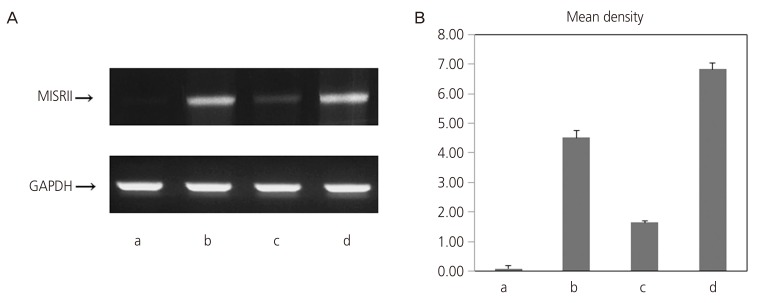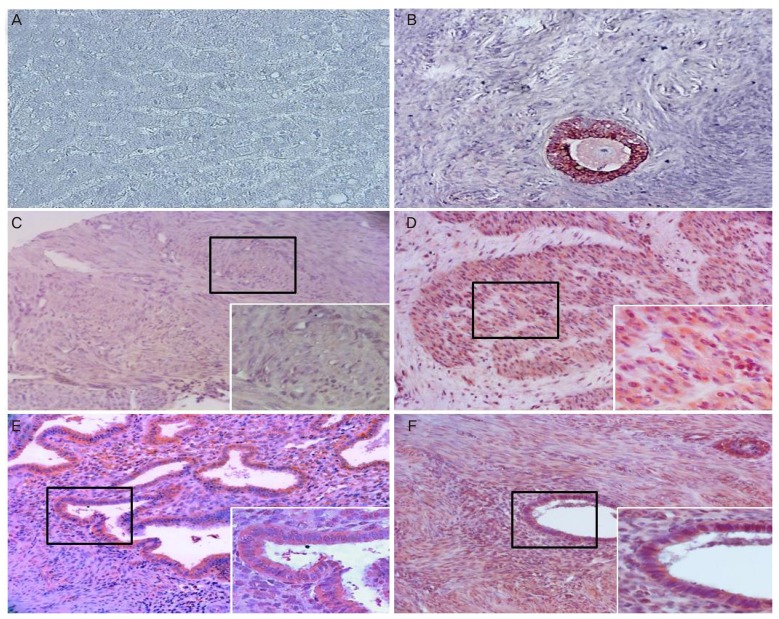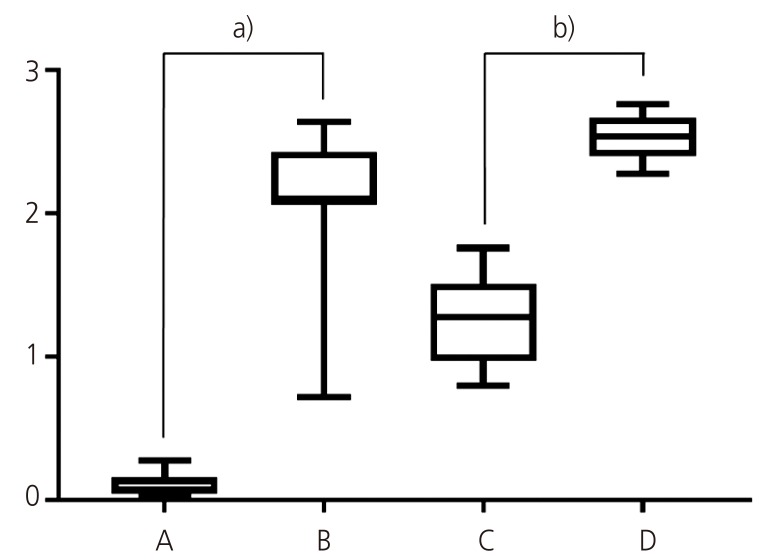Obstet Gynecol Sci.
2018 Jan;61(1):127-134. 10.5468/ogs.2018.61.1.127.
The expression of Müllerian inhibiting substance/anti-Müllerian hormone type II receptor in myoma and adenomyosis
- Affiliations
-
- 1Department of Obstetrics and Gynecology, Seoul St. Mary's Hospital, The Catholic University of Korea College of Medicine, Seoul, Korea. janghkim@catholic.ac.kr
- KMID: 2420161
- DOI: http://doi.org/10.5468/ogs.2018.61.1.127
Abstract
OBJECTIVE
We compared the expression levels of Müllerian inhibiting substance (MIS)/anti-Müllerian hormone type II receptor (AMHRII) in uterine myoma and adenomyosis to evaluate the possibility of using MIS/anti-Müllerian hormone (AMH) as a biological regulator or therapeutic agent in patients with uterine leiomyoma and adenomyosis.
METHODS
We studied normal uterine myometrium, leiomyoma, endometrial tissue, and adenomyosis from 57 patients who underwent hysterectomy for uterine leiomyoma (22 cases) or adenomyosis (28 cases) and myomectomy for uterine myoma (7 cases). Immunohistochemical staining was used to confirm the MIS/AMHRII protein expression level in each tissue. Reverse transcription-polymerase chain reaction was performed to quantify MIS/AMHRII mRNA expression.
RESULTS
The MIS/AMHRII protein was more strongly expressed in uterine myoma (frequency of MIS/AMHRII expressing cells: 51.95%±13.96%) and adenomyosis (64.65%±4.85%) tissues than that in the normal uterine myometrium (3.15%±1.69%) and endometrium (31.10%±7.19%). In the quantitative analysis of MIS/AMHRII mRNA expression, MIS/AMHRII mRNA expression levels in uterine myoma (mean density: 4.51±0.26) and adenomyosis (6.84±0.20) tissues were higher than that in normal uterine myometrial tissue (0.08±0.09) and endometrial tissue (1.63±0.06).
CONCLUSION
This study demonstrated that MIS/AMHRII was highly and strongly expressed on uterine myoma and adenomyosis. Our data suggest that MIS/AMH may be evaluated as a biological modulator or therapeutic agent on MIS/AMHRII expressing uterine myoma and adenomyosis.
MeSH Terms
Figure
Reference
-
1. Rey R, Lukas-Croisier C, Lasala C, Bedecarrás P. AMH/MIS: what we know already about the gene, the protein and its regulation. Mol Cell Endocrinol. 2003; 211:21–31. PMID: 14656472.
Article2. He WW, Gustafson ML, Hirobe S, Donahoe PK. Developmental expression of four novel serine/threonine kinase receptors homologous to the activin/transforming growth factor-beta type II receptor family. Dev Dyn. 1993; 196:133–142. PMID: 8395914.3. MacLaughlin DT, Donahoe PK. Mullerian inhibiting substance: a potential nontoxic, naturally occurring therapeutic agent for certain human cancers. In : Jakowlew SB, editor. Transforming growth factor-β in cancer therapy: volume I basic and clinical biology. Totowa (NJ): Humana Press;2008. p. 333–353.4. Kim JH. Müllerian inhibiting substance: physiology and clinical applications. J Womens Med. 2009; 2:45–47.5. Lee HB, Jung YJ, Kim MJ, Cho HH, Kim MR, Kim EJ, et al. Expression of Müllerian Inhibiting Substance (MIS) and its receptor in female genital tract. World J Pathol. 2013; 2:14–24.6. Fanchin R, Taieb J, Lozano DH, Ducot B, Frydman R, Bouyer J. High reproducibility of serum anti-Mullerian hormone measurements suggests a multi-staged follicular secretion and strengthens its role in the assessment of ovarian follicular status. Hum Reprod. 2005; 20:923–927. PMID: 15640257.7. Hudson PL, Dougas I, Donahoe PK, Cate RL, Epstein J, Pepinsky RB, et al. An immunoassay to detect human müllerian inhibiting substance in males and females during normal development. J Clin Endocrinol Metab. 1990; 70:16–22. PMID: 2294129.8. Lee MM, Donahoe PK, Hasegawa T, Silverman B, Crist GB, Best S, et al. Mullerian inhibiting substance in humans: normal levels from infancy to adulthood. J Clin Endocrinol Metab. 1996; 81:571–576. PMID: 8636269.
Article9. Chin TW, Parry RL, Donahoe PK. Human müllerian inhibiting substance inhibits tumor growth in vitro and in vivo . Cancer Res. 1991; 51:2101–2106. PMID: 2009529.10. Fuller AF Jr, Krane IM, Budzik GP, Donahoe PK. Mullerian inhibiting substance reduction of colony growth of human gynecologic cancers in a stem cell assay. Gynecol Oncol. 1985; 22:135–148. PMID: 3932140.
Article11. Kim JH, MacLaughlin DT, Donahoe PK. Müllerian inhibiting substance/anti-Müllerian hormone: a novel treatment for gynecologic tumors. Obstet Gynecol Sci. 2014; 57:343–357. PMID: 25264524.
Article12. Stephen AE, Pearsall LA, Christian BP, Donahoe PK, Vacanti JP, MacLaughlin DT. Highly purified müllerian inhibiting substance inhibits human ovarian cancer in vivo . Clin Cancer Res. 2002; 8:2640–2646. PMID: 12171896.13. Park SH, Chung YJ, Song JY, Kim SI, Pépin D, MacLaughlin DT, et al. Müllerian inhibiting substance inhibits an ovarian cancer cell line via β-catenin interacting protein deregulation of the Wnt signal pathway. Int J Oncol. 2017; 50:1022–1028. PMID: 28197641.
Article14. Masiakos PT, MacLaughlin DT, Maheswaran S, Teixeira J, Fuller AF Jr, Shah PC, et al. Human ovarian cancer, cell lines, and primary ascites cells express the human Mullerian inhibiting substance (MIS) type II receptor, bind, and are responsive to MIS. Clin Cancer Res. 1999; 5:3488–3499. PMID: 10589763.15. Ha TU, Segev DL, Barbie D, Masiakos PT, Tran TT, Dombkowski D, et al. Mullerian inhibiting substance inhibits ovarian cell growth through an Rb-independent mechanism. J Biol Chem. 2000; 275:37101–37109. PMID: 10958795.16. Song JY, Chen KY, Kim SY, Kim MR, Ryu KS, Cha JH, et al. The expression of Müllerian inhibiting substance/anti-Müllerian hormone type II receptor protein and mRNA in benign, borderline and malignant ovarian neoplasia. Int J Oncol. 2009; 34:1583–1591. PMID: 19424576.
Article17. Nam SW, Jo YS, Eun JW, Song JY, Ryu KS, Lee JY, et al. Identification of large-scale characteristic genes of Müllerian inhibiting substance in human ovarian cancer cells. Int J Mol Med. 2009; 23:589–596. PMID: 19360316.
Article18. Wang JJ, Roffler SR, Chou HH, Yin FY, Yin CS. Characterization of mullerian inhibiting substance binding on cervical carcinoma cells demonstrated by immunocytochemistry. Tissue Cell. 1994; 26:467–476. PMID: 8073421.
Article19. Song JY, Jo HH, Kim MR, Lew YO, Ryu KS, Cha JH, et al. Expression of Müllerian inhibiting substance type II receptor and antiproliferative effects of MIS on human cervical cancer. Int J Oncol. 2012; 40:2013–2021. PMID: 22344630.
Article20. Hwang SJ, Suh MJ, Yoon JH, Kim MR, Ryu KS, Nam SW, et al. Identification of characteristic molecular signature of Müllerian inhibiting substance in human HPV-related cervical cancer cells. Int J Oncol. 2011; 39:811–820. PMID: 21573503.
Article21. Barbie TU, Barbie DA, MacLaughlin DT, Maheswaran S, Donahoe PK. Mullerian Inhibiting Substance inhibits cervical cancer cell growth via a pathway involving p130 and p107. Proc Natl Acad Sci USA. 2003; 100:15601–15606. PMID: 14671316.
Article22. Renaud EJ, MacLaughlin DT, Oliva E, Rueda BR, Donahoe PK. Endometrial cancer is a receptor-mediated target for Mullerian Inhibiting Substance. Proc Natl Acad Sci USA. 2005; 102:111–116. PMID: 15618407.
Article23. Chung YJ, Kim HJ, Park SH, Yoon JH, Kim MR, Nam SW, et al. Transcriptome analysis reveals that Müllerian inhibiting substance regulates signaling pathways that contribute to endometrial carcinogenesis. Int J Oncol. 2015; 46:2039–2046. PMID: 25760378.
Article24. Namkung J, Song JY, Jo HH, Kim MR, Lew YO, Donahoe PK, et al. Mullerian inhibiting substance induces apoptosis of human endometrial stromal cells in endometriosis. J Clin Endocrinol Metab. 2012; 97:3224–3230. PMID: 22761458.25. Parker WH. Etiology, symptomatology, and diagnosis of uterine myomas. Fertil Steril. 2007; 87:725–736. PMID: 17430732.
Article27. Yen CF, Huang SJ, Lee CL, Wang HS, Liao SK. Molecular characteristics of the endometrium in uterine adenomyosis and its biochemical microenvironment. Reprod Sci. 2017; 24:1346–1361. PMID: 28183227.
Article28. Pérez-López FR, Ornat L, Ceausu I, Depypere H, Erel CT, Lambrinoudaki I, et al. EMAS position statement: management of uterine fibroids. Maturitas. 2014; 79:106–116. PMID: 24975954.
Article
- Full Text Links
- Actions
-
Cited
- CITED
-
- Close
- Share
- Similar articles
-
- A Rare Case of Intramural Müllerian Adenosarcoma Arising from Adenomyosis of the Uterus
- Clinical application of serum anti-Müllerian hormone in women
- The meaning of anti-Müllerian hormone levels in patients at a high risk of poor ovarian response
- A successful laparoscopic neovaginoplasty using peritoneum in Müllerian agenesis with inguinal ovaries accompanied by primary ovarian insufficiency
- Serum Anti-Müllerian Hormone Levels in Precocious Puberty Girls according to Stage of GnRH Agonist Treatment




